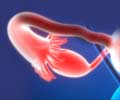Ewing sarcoma may be treated effectively by controlling the expression of the genes EWS and FLI-1. It also controls the growth of cells in other types of pediatric tumors originating from neural stem cells.

‘Treatment of cells from pediatric cancer tumors with compounds that modify DNA packing can cause the cells to acquire normal cell features and lose their cancerous properties.’





Typically, the pathogenesis of Ewing sarcoma includes fusion of the EWS and FLI-1 genes. The resulting EWSR1-FLI-1 protein induces aberrant epigenomic reprogramming, which alters acetylation and methylation, leading to chromatin remodeling. Chromatin is a structurally condensed form of DNA, and its condensation state regulates gene expression patterns epigenetically. Highly condensed chromatin can suppress the expression of genes that control differentiation, thereby keeping cancer cells in a poorly differentiated, stem cell-like state that facilitates tumor progression.A team of researchers at the Cancer and Neurobiology Laboratory and the Pediatric Oncology Service at the Federal University of Rio Grande do Sul (UFRGS) and its university hospital, along with other institutes have targeted proteins that regulate the chromatin state of DNA in Ewing sarcoma cells with the goal of hindering malignant tumor growth.
In a new study published in the journal Molecular Neurobiology, lead author Dr. Barbara Kunzler Souza and colleagues were able to induce chromatic relaxation in Ewing sarcoma cells by treating them with a compound that inhibits histone deacetylases. The treatment reduced expression of the EWSR1-FLI-1 oncogene as well as expression of other genes associated with pluripotency and cell viability, while impairing the cells' ability to survive and proliferate. Decreased survival of stem-like cancer cells and re-expression of a neuronal differentiation marker were also observed.
In a previous study by the same group, Dr. Viviane Rösner de Almeida and colleagues demonstrated that treating human neuroblastoma cells with epigenetic agents that inhibit either histone deacetylases or DNA methyltransferase potentiated the ability of a retinoid-based therapy to impair cell proliferation and reduced the expression of oncogene products, including c-Myc and Bmi1.
Neuroblastoma, the most common extracranial solid childhood cancer accounting for 15 percent of pediatric cancer deaths, is another pediatric cancer thought to originate from a developmental malfunction of embryonic neural crest cells. Dr. Rafael Roesler, associate professor of pharmacology at UFRGS and senior author of the studies, has said that "targeting epigenetic processes that regulate chromatin state, such as histone acetylation and DNA methylation, seems to be an effective experimental approach to inducing desirable biological changes in cells from childhood tumors that may arise from defects in embryonic development."
Advertisement
Source-Eurekalert















